DAHLIAS
(Last updated 1/28/06)
Most of the pix below were taken in
the fields and display gardens of Swan Island Dahlias in Canby,
OR. Swan Island is the largest dahlia grower in the United States,
and also one of its premier hybridizers, introducing as many as
15 new varieties each season. The McCarter family started the
business in the late 1920s on farmland in Portland, but moved
the operation ca 25 miles south in the '40s. Today Swan Island,
purchased in 1963 by Nick and Marge Gitts, covers over 40 acres
in Canby and is managed by two new generations of the Gitts family.
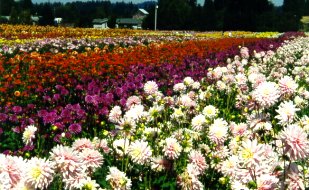
 Dahlias are members of the Sunflower
(Composite - Asteraceae) family, related to the chrysanthemums,
marigolds, zinnias, and daisies. Wild species come from the
highlands of southern Mexico and Central America, have simple,
single-colored blooms, and range from several inches in height
to over 30 feet tall (plants with bamboo-like hollow stems over
3" in diameter). A recent taxonomic compendium listed 33
species divided into four sections [Pseudodendron (3, including
D. imperialis, the giant tree dahlia), Epiphytum (1), Entemophyllon
(6), and Dahlia (23, including D. coccinea)], but several new
species have apparently been discovered since then.
Dahlias are members of the Sunflower
(Composite - Asteraceae) family, related to the chrysanthemums,
marigolds, zinnias, and daisies. Wild species come from the
highlands of southern Mexico and Central America, have simple,
single-colored blooms, and range from several inches in height
to over 30 feet tall (plants with bamboo-like hollow stems over
3" in diameter). A recent taxonomic compendium listed 33
species divided into four sections [Pseudodendron (3, including
D. imperialis, the giant tree dahlia), Epiphytum (1), Entemophyllon
(6), and Dahlia (23, including D. coccinea)], but several new
species have apparently been discovered since then.

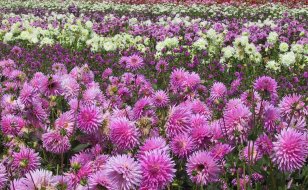 The Aztecs, who cultivated dahlias
as ornamentals, as well as using their tubers for animal feed
and as a source of medicine, had many names for the plant, most
prominently Acocotli - 'water throat' (the stems provided an emergency
water supply for roving hunters), Cocoxochitl - 'water pipe',
and Chichipatli - 'bitter medicine'.
The Aztecs, who cultivated dahlias
as ornamentals, as well as using their tubers for animal feed
and as a source of medicine, had many names for the plant, most
prominently Acocotli - 'water throat' (the stems provided an emergency
water supply for roving hunters), Cocoxochitl - 'water pipe',
and Chichipatli - 'bitter medicine'.

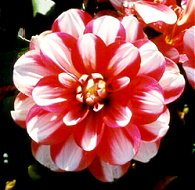
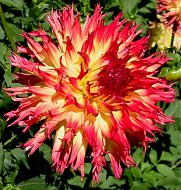 The physician/botanist Francisco Hernandez
provided the first modern description of the dahlia in his treatise
"Plantas y Animales de la Nueva Espana" (published in
Mexico in 1615), but dahlias didn't become established in Europe
until 1789, when the Abbe Antonia Jose Cavanilles of the Royal
Botanic Gardens in Madrid received a parcel of seeds from Mexico.
Cavanilles planted them, got them to flower, and in 1791 described
two types of Mexican Acocotli in his "Icones et Descriptiones
Plantarum". He placed both - a half double purple species
and a species with single, brilliant red flowers on 4' stems -
into a new genus, Dahlia, named in honor of Andreas Dahl, a recently
deceased Swedish botanist and student of Linnaeus.
The physician/botanist Francisco Hernandez
provided the first modern description of the dahlia in his treatise
"Plantas y Animales de la Nueva Espana" (published in
Mexico in 1615), but dahlias didn't become established in Europe
until 1789, when the Abbe Antonia Jose Cavanilles of the Royal
Botanic Gardens in Madrid received a parcel of seeds from Mexico.
Cavanilles planted them, got them to flower, and in 1791 described
two types of Mexican Acocotli in his "Icones et Descriptiones
Plantarum". He placed both - a half double purple species
and a species with single, brilliant red flowers on 4' stems -
into a new genus, Dahlia, named in honor of Andreas Dahl, a recently
deceased Swedish botanist and student of Linnaeus.
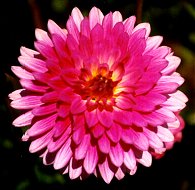
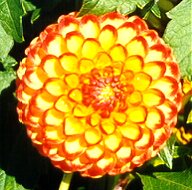
 Dahlias spread to the rest of Europe
in 1802 when Cavanilles provided seeds to botanists in France.
The following year the German geographer von Humboldt sent seeds
from Mexico to Karl Ludwig Wildenow, a Berlin botanist. Then in
1804, the Lady Holland brought seeds to England from Spain, and
John Fraser, an English nurseryman, got plants to flower in his
greenhouse. By 1805 horticulturists in Britain, France, Germany,
and the Netherlands were propagating the dahlia, and by 1810,
were developing new colors, as well as changing flower fullness,
symmetry, and petal shape.
Dahlias spread to the rest of Europe
in 1802 when Cavanilles provided seeds to botanists in France.
The following year the German geographer von Humboldt sent seeds
from Mexico to Karl Ludwig Wildenow, a Berlin botanist. Then in
1804, the Lady Holland brought seeds to England from Spain, and
John Fraser, an English nurseryman, got plants to flower in his
greenhouse. By 1805 horticulturists in Britain, France, Germany,
and the Netherlands were propagating the dahlia, and by 1810,
were developing new colors, as well as changing flower fullness,
symmetry, and petal shape.


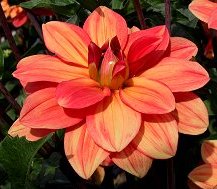 When it was first introduced as a garden
plant, the dahlia was called D. superflua, but it quickly became
known as D. variabilis, perhaps to honor the frustrated gardeners
who often found flowers of two different colors or kinds on the
same plant. To add to the confusion, when plants reached Berlin
in 1804, Wildenow renamed the genus Georgina because he believed
that a friend of Dahl's had already used Dahlia for a genus of
leguminous plants; thus when dahlias were first introduced into
the United States in the 1810s, they were called "Mexican
georginas". Although the name officially reverted to Dahlia
when it was determined that Cavanilles had published first (by
a year), old names die hard and Georgina is still used in some
parts of Europe.
When it was first introduced as a garden
plant, the dahlia was called D. superflua, but it quickly became
known as D. variabilis, perhaps to honor the frustrated gardeners
who often found flowers of two different colors or kinds on the
same plant. To add to the confusion, when plants reached Berlin
in 1804, Wildenow renamed the genus Georgina because he believed
that a friend of Dahl's had already used Dahlia for a genus of
leguminous plants; thus when dahlias were first introduced into
the United States in the 1810s, they were called "Mexican
georginas". Although the name officially reverted to Dahlia
when it was determined that Cavanilles had published first (by
a year), old names die hard and Georgina is still used in some
parts of Europe.
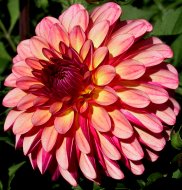
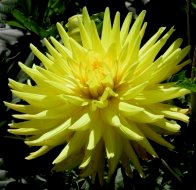
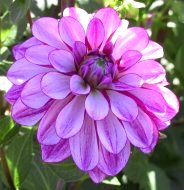 New Dahlia varieties can be developed
from seed, but are often derived from "sports" (natural
mutations). Wild dahlias have eight sets of chromosomes (2n =32,
with at least two sets coming from a second species), cultivated
dahlias twice that many - which explains the wildly divergent
results that can be obtained from crosses. More than 20,000 dahlia
cultivars are recorded in the UK's "International Registry
of Dahlias", and as many as 50,000 may exist worldwide.
New Dahlia varieties can be developed
from seed, but are often derived from "sports" (natural
mutations). Wild dahlias have eight sets of chromosomes (2n =32,
with at least two sets coming from a second species), cultivated
dahlias twice that many - which explains the wildly divergent
results that can be obtained from crosses. More than 20,000 dahlia
cultivars are recorded in the UK's "International Registry
of Dahlias", and as many as 50,000 may exist worldwide.
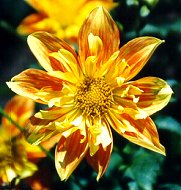

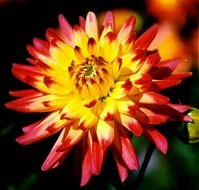 For descriptive (and show) purposes,
the American Dahlia Society (founded in 1915) divides dahlias
- which come in every color and color combination from white to
purple (except blue and black) - into 15 color groups, and flowers
- which can reach 14" in diameter - into five size categories.
For descriptive (and show) purposes,
the American Dahlia Society (founded in 1915) divides dahlias
- which come in every color and color combination from white to
purple (except blue and black) - into 15 color groups, and flowers
- which can reach 14" in diameter - into five size categories.

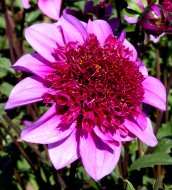
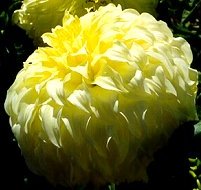 The ADS also classifies dahlias into
18 groups based on flower shape (form) and petal (more properly,
ray floret) characteristics. Modern Singles (S; left), which closely
resemble the flowers of wild species, have an open center with
flat, rounded petals; Mignon Singles (MS; right), first developed
ca 1908, are identical, except that their blooms are less than
2" across.
The ADS also classifies dahlias into
18 groups based on flower shape (form) and petal (more properly,
ray floret) characteristics. Modern Singles (S; left), which closely
resemble the flowers of wild species, have an open center with
flat, rounded petals; Mignon Singles (MS; right), first developed
ca 1908, are identical, except that their blooms are less than
2" across.
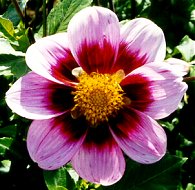
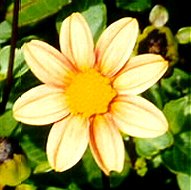 The Anemone form (AN; left), which
first appeared ca 1830, has a ring of petals similar to the Single,
but with a prominent central tuft of tubular florets. The Collarette
form (CO; center), developed ca 1900, is similar to the Single,
but with an inner ring of smaller florets surrounding the open
center disc. The semi-double Peony form (PE; right), with several
rows of rounded petals surrounding an open center disc, also became
available ca 1900.
The Anemone form (AN; left), which
first appeared ca 1830, has a ring of petals similar to the Single,
but with a prominent central tuft of tubular florets. The Collarette
form (CO; center), developed ca 1900, is similar to the Single,
but with an inner ring of smaller florets surrounding the open
center disc. The semi-double Peony form (PE; right), with several
rows of rounded petals surrounding an open center disc, also became
available ca 1900.
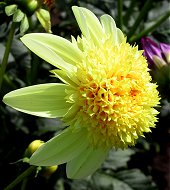

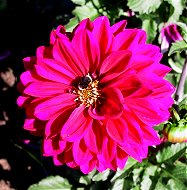 Globe-shaped dahlias apparently developed
from the double blooms generated by Donkelaar at the Botanic Garden
in Louvain ca 1814. The modern Ball (BA; left) and Miniature Ball
(MB) are identical except for size (BA over 3.5", MB 2-3.5"
in diameter); the petals also curl toward the center of the flower
(are 'involute') along more than half their length. The Pompon
(P - named after the "bobble" on a French sailor's hat;
right), developed ca 1850 in Germany, is similar to the Ball,
but petals are curled along their entire length, and blooms are
less than 2" in diameter.
Globe-shaped dahlias apparently developed
from the double blooms generated by Donkelaar at the Botanic Garden
in Louvain ca 1814. The modern Ball (BA; left) and Miniature Ball
(MB) are identical except for size (BA over 3.5", MB 2-3.5"
in diameter); the petals also curl toward the center of the flower
(are 'involute') along more than half their length. The Pompon
(P - named after the "bobble" on a French sailor's hat;
right), developed ca 1850 in Germany, is similar to the Ball,
but petals are curled along their entire length, and blooms are
less than 2" in diameter.
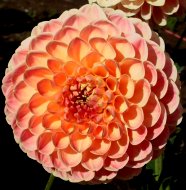
 In 1872 a shipment of dahlia tubers
sent from Mexico to Holland produced a plant with brilliant red
double blooms and petals that were curled (away from the center
of the flower, 'revolute') from base to tip (quilled). This new
variety - D. juarezii, or "star of the devil" - was
the first of the European cactus-flowers. There are now four Cactus
groups: the Straight Cactus (C; left); the Incurved Cactus (IC;
center), in which the petals also curve upward toward the center
of the flower; the Semi-Cactus (SC; right), in which the petals
are rolled up along less than half their length...
In 1872 a shipment of dahlia tubers
sent from Mexico to Holland produced a plant with brilliant red
double blooms and petals that were curled (away from the center
of the flower, 'revolute') from base to tip (quilled). This new
variety - D. juarezii, or "star of the devil" - was
the first of the European cactus-flowers. There are now four Cactus
groups: the Straight Cactus (C; left); the Incurved Cactus (IC;
center), in which the petals also curve upward toward the center
of the flower; the Semi-Cactus (SC; right), in which the petals
are rolled up along less than half their length...
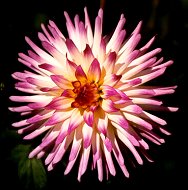
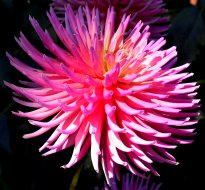
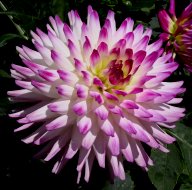 ...and the Laciniated Cactus (LC; left),
in which the petals have split ends, giving the flower a lacy
or fringed look. The forerunners of the Decorative form first
appeared ca 1903. Modern Decoratives are divided into two groups:
the Formal Decoratives (FD) are fully double blooms, with petals
usually flat and rounded (center), but sometimes slightly pointed
or involute or 'recurved' (bent toward the stem; right), arranged
in an even, regular pattern throughout the flower.
...and the Laciniated Cactus (LC; left),
in which the petals have split ends, giving the flower a lacy
or fringed look. The forerunners of the Decorative form first
appeared ca 1903. Modern Decoratives are divided into two groups:
the Formal Decoratives (FD) are fully double blooms, with petals
usually flat and rounded (center), but sometimes slightly pointed
or involute or 'recurved' (bent toward the stem; right), arranged
in an even, regular pattern throughout the flower.
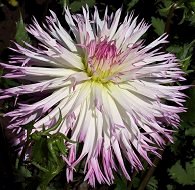
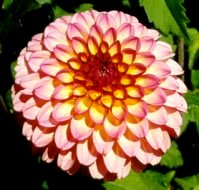
 The Informal Decoratives (ID; left)
are similar, but have petals that are twisted, partially revolute,
or even wavy, creating an irregular-appearing petal arrangement.
The Waterlily (WL; center) is also a full double, but characterized
by broad, sparsely spaced petals that are either flat or slightly
involute.The new Orchid group (O; right) has a single row of evenly
spaced petals around an open disc center like a Single, but the
petals are involute for at least 2/3 of their length, fully involute
for at least the outer 1/3.
The Informal Decoratives (ID; left)
are similar, but have petals that are twisted, partially revolute,
or even wavy, creating an irregular-appearing petal arrangement.
The Waterlily (WL; center) is also a full double, but characterized
by broad, sparsely spaced petals that are either flat or slightly
involute.The new Orchid group (O; right) has a single row of evenly
spaced petals around an open disc center like a Single, but the
petals are involute for at least 2/3 of their length, fully involute
for at least the outer 1/3.
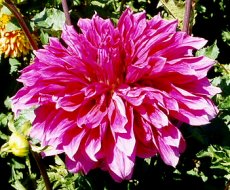
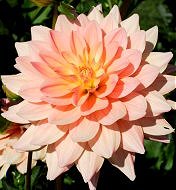
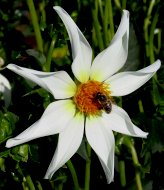 The Stellars (ST; left), the newest
group, are fully double, with small, immature inner petals gradually
changing to large, fully mature outer petals, and with the outermost
petals fully involute. Novelty forms have flowers that don't fit
into any of the other categories: those of the Open Center group
(NO; center) have a distinct center disc, while those of the Full
Double group (NX; right) have none.
The Stellars (ST; left), the newest
group, are fully double, with small, immature inner petals gradually
changing to large, fully mature outer petals, and with the outermost
petals fully involute. Novelty forms have flowers that don't fit
into any of the other categories: those of the Open Center group
(NO; center) have a distinct center disc, while those of the Full
Double group (NX; right) have none.
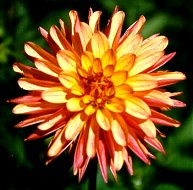
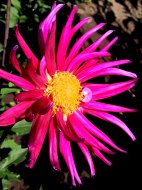
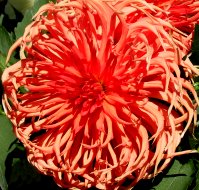 Interesting link: American
Dahlia Society | Return
to Home Page
Interesting link: American
Dahlia Society | Return
to Home Page










































